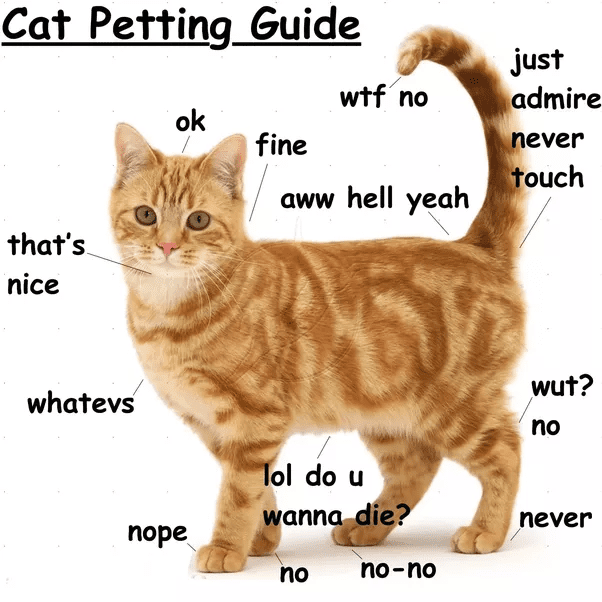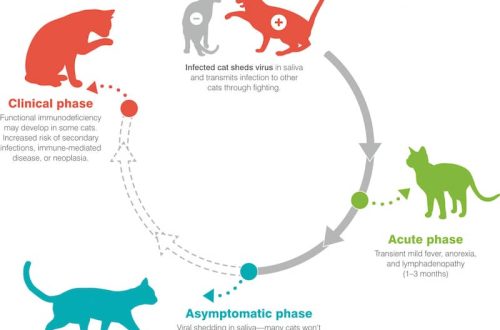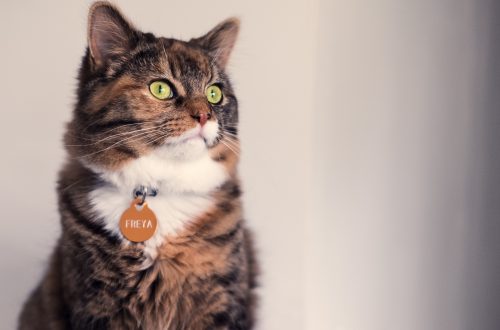
Do cats like being stroked, and how to do it right?
A few years ago, the journal Frontiers in Psychology confirmed what pet owners already knew: positive interactions with animals reduce stress in humans. This is great news for human health and longevity, but cat owners often wonder if the feeling is mutual.
Can you pet a cat? How to pet a cat? And what if the cat scratches and bites when you stroke it?
Many cats, despite the widespread and persistent myth about their coldness, love affection from their owners. Why do cats love to be stroked? When the owner strokes the cat or picks it up, it strengthens their relationship.
Contents
Where to stroke a cat and how
Petting a cat can be a very difficult task. You can misinterpret her signals and end up touching her the wrong way or in a place she doesn’t like.
 For example, a cat spins on the floor and exposes its tummy. So she shows that she trusts the owner. But stroking a cat’s belly is not a good idea. She will probably respond with a scratch or a bite. So she says she doesn’t want to be stroked in this very place at this very moment. The cat will let you stroke the belly if it likes it, Petful explains, but this should be done carefully and only when the cat is calm, relaxed and trusts you.
For example, a cat spins on the floor and exposes its tummy. So she shows that she trusts the owner. But stroking a cat’s belly is not a good idea. She will probably respond with a scratch or a bite. So she says she doesn’t want to be stroked in this very place at this very moment. The cat will let you stroke the belly if it likes it, Petful explains, but this should be done carefully and only when the cat is calm, relaxed and trusts you.
In 2013, a study in the journal Physiology & Behavior was misinterpreted as evidence that petting cats causes them stress. John Bradshaw, director of the Institute of Anthrozoology at the University of Bristol in England, assured National Geographic that the anxiety of the test cats was due to events in their lives, and not petting. In the course of the experiment, the differences between stress in cats living alone and stress in cats living in families with several cats were studied. Stroking can comfort your pet, so don’t be afraid to pet him.
Head, shoulders, cheeks and nose
Most often, cats love to be stroked on the head, chin and neck. Some of them enjoy touching their tail, but others recoil and even experience pain. Do not rush things, carefully watching the cat’s reaction to touch and respecting her preferences.
When looking for approaches to your cat, the most important thing is to let her take the lead. First you need to let the cat sniff the index finger and touch it with his nose. If the cat is ready to receive petting, she will press her muzzle to her hand and point it to her ears, chin, or other place where she wants to be stroked. Slow movements will create a more relaxed and warm atmosphere. If she starts butting her head or rubbing her cheek, that’s a good sign. It is through this behavior that pets leave the smell of their buccal glands on their favorite furnishings and owners.
Most cats like to snuggle up to their owners, and they usually enjoy being held if they get used to it gradually. Before cuddling your cat tightly, it’s best to start with a few gentle strokes and then gently pick it up. It is imperative to hold all four paws of the animal so that they do not hang down.
If she feels safe in her arms, she will enjoy it more. If she breaks away trying to escape, you should carefully release her and try again later. It takes small steps to teach your pet to tactile contact, and sometimes a tasty reward as a thank you for not scratching your hands. By the way, whatever the relationship, you should not stroke the cat against the wool.
What influences a cat’s love for strokes
Some cat breeds are more receptive to petting and hugging than others. The Siamese cat, for example, is a playful and fun breed that will require a lot of attention, just like the affectionate Ragdoll.
Don’t be alarmed if your cat resists physical contact. It may just be a trait of her character or part of her upbringing. If a cat has had little contact with people at an early age, it may be reluctant to accept petting.
She may need more persuasion if she was taken into the family as an adult. You need to help your pet acclimate using some of the strategies above. But there are animals that just don’t like being picked up: they prefer to be a cat lying next to them, rather than a cat lying on their laps.
Building trust is a gradual process in any relationship. Giving a cat love and affection, the owner will be rewarded with the best feline friend in the world. And maybe he’ll even let you scratch his tummy once.





